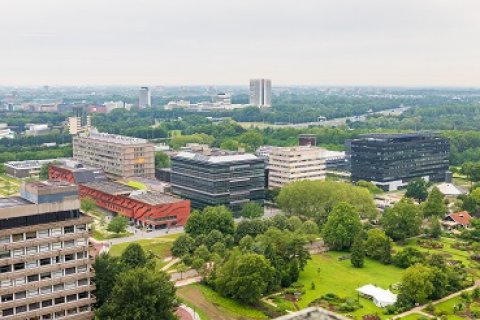Application for natural gas-free testing ground at Utrecht Science Park

Utrecht is asking the government for a contribution of 5 million euros to accelerate the transition of Utrecht Science Park to a gas-free environment. Utrecht University wishes to eliminate the use of natural gas from the Willem C. van Unnik, Educatorium and Marinus Ruppert buildings by 2028 and the University Medical Centre Utrecht wishes to do the same for part of the Wilhelmina Children's Hospital. Further research is needed to see whether other buildings and offices in the area can also be made more sustainable and heated and cooled without the use of natural gas. Utrecht is making the application via the Gas-Free Neighbourhood testing ground regulations.
Thermal energy storage
Utrecht Science Park is home to 128 companies and 2,600 student residences. Most of the energy they need is still supplied by gas or natural gas-fired boilers and power plants. Both the university and UMC Utrecht have already done a great deal to increase their sustainability in recent years. For example, in 2016 the two organisations installed a total of 7,000 solar panels. They are also implementing energy-saving measures during renovations. A financial contribution from the government will allow them to make their buildings extremely energy-efficient and therefore suitable for thermal energy storage. This is a sustainable method of storing energy in the soil and thus heating or cooling buildings. HU University of Applied Sciences Utrecht and SSH Student Housing may also be able to link to a thermal energy network.
Cooperation
By applying to become a testing ground, the municipality wishes to support these plans and simultaneously encourage broad cooperation in the area. Many of the buildings are interconnected via their energy networks. For this reason, a budget was also requested for research into the possible expansion and interconnection of thermal energy networks throughout the area. Connecting existing buildings to thermal energy systems is already rather complex, but large-scale application is highly innovative. The plan is to implement the testing ground plan between now and 2028. The ambition is for Utrecht Science Park to become gas-free as soon as possible, by 2040 at the latest.
The living lab will ensure that we can learn, broaden the collaboration and make meters towards a sustainable future faster.
Sustainability ambitions
Executive Board President Anton Pijpers is enthusiastic. "We are very happy with this initiative and hope that the subsidy application will be honoured. This helps us with our sustainability ambitions for the Utrecht Science Park. The living lab will ensure that we can learn, broaden the collaboration and make meters towards a sustainable future faster".
'We are delighted with the big ambitions of the parties involved', says Alderman Lot van Hooijdonk (Energy). 'However, there are still obstacles to be overcome in the areas of technology, cooperation and finances. Without a testing ground subsidy, it will not currently be possible to make the transition to gas-free. We want to find out how this would work in a large business park. We can apply the experience gained with the first four buildings to the whole of Utrecht Science Park and the rest of the city.'
Testing ground for gas-free neighbourhoods
For the second time, the government has asked all the municipalities to submit a proposal for a testing ground (Gas-free neighbourhoods). In the years ahead, the Netherlands wishes to convert about 100 neighbourhoods to gas-free neighbourhoods. In 2018, 27 testing grounds were launched to gain knowledge and experience for a neighbourhood-oriented approach. In Utrecht, the Overvecht-Noord district is the first testing ground; Utrecht Science Park could become the second. The successful proposals are expected to be announced this autumn. Together with Energie-U, the municipality has developed an approach for submitting an application with a neighbourhood initiative in the third round.

